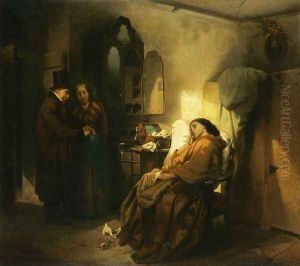Vicenzo Cabianca Paintings
Vincenzo Cabianca was an Italian painter who was born on February 22, 1827, in Verona, Italy. He was part of the artistic movement known as the Macchiaioli, which emerged in Italy during the late 1850s. The Macchiaioli were a group of Tuscan painters who rebelled against the formalism of the academically sanctioned historical and classical styles of painting and were precursors of the Impressionists in France. They focused on painting their immediate surroundings and emphasized the use of 'macchie' or patches of color to capture the effects of light and atmosphere in their work.
Cabianca received his initial training at the Accademia di Belle Arti di Verona under the Neoclassical painter Epaminonda Bignami. He later moved to Rome in 1846, where he became influenced by the Nazarenes, a group of German Romantic painters who aimed to revive the spirit and techniques of medieval and early Renaissance art. Cabianca's early works reflect this influence through their religious and historical subjects.
In the 1850s, Cabianca relocated to Florence, which was a hub of activity and intellectual discourse for the Macchiaioli. There, he became associated with the Caffè Michelangiolo, a gathering place for many of the movement's artists, including Telemaco Signorini and Giovanni Fattori. It was during this period that his style began to shift towards the plein air painting and the loose brushwork characteristic of the Macchiaioli. His subjects included landscapes, genre scenes, and occasional portraits, often characterized by a subdued palette and an interest in capturing the transient effects of light.
Throughout his career, Cabianca exhibited his works in various Italian cities and was involved in the Promotrice Fiorentina from its foundation. He also participated in the Paris Exposition Universelle in 1855. Despite being less well-known than some of his contemporaries, Cabianca's contributions to the Macchiaioli movement were significant, and his works were appreciated for their poetic sensitivity and atmospheric qualities.
Vincenzo Cabianca died on March 21, 1902, in Rome. His paintings are held in several important collections, including the Galleria d'Arte Moderna in Florence and the Galleria Nazionale d'Arte Moderna in Rome. His work continues to be recognized for its role in the development of modern Italian painting and for its influence on the broader Impressionist movement that flourished in Europe.
